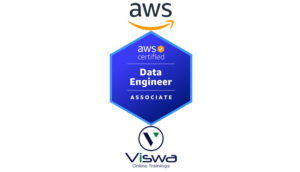Data Science Certification Training
One of the top providers of online IT training worldwide is VISWA Online Trainings. To assist beginners and working professionals in achieving their career objectives and taking advantage of our best services, We provide a wide range of courses and online training.
Learners : 1080
Duration : 3 Months
About Course
Our Data Science Course may be characterized as a fusion of mathematics, business acumen, tools, algorithms, and machine learning approaches, all of which assist us in identifying hidden patterns or insights from unstructured data that can be crucial in the development of important business decisions. Data science makes use of both organized and unstructured data. The algorithms also use predictive analytics. Data science is therefore concerned with the present and the future. Enrol today to earn your certification.
Data Science Training Course Syllabus
✔ What is Machine learning
✔ Who is a Data Scientist
✔ How ML is Different from Programming Languages
✔ Use cases of ML
✔ Techniques used in ML
✔ Data Collection
✔ Data Cleansing
✔ Data Visualization
✔ Web Scrapping
✔ Why Python for Machine Learning
✔ Installing Python
✔ Python IDE’s
✔ Writing the First Python Programme
✔ Executing of Python programs
✔ Integer
✔ Float
✔ String
✔ Bool
✔ Relational Operators
✔ Arithmetic Operators
✔ Logical Operators
✔ Concatenation Operator
✔ Lists
✔ Tuples
✔ Sets
✔ Dictionaries
✔ Range
✔ If and else if statements
✔ For and while Statements
✔ Iterables and Iterators
✔ List Comprehensions and Generators
✔ Case Study
✔ Writing user-defined functions
✔ Lambda Functions
✔ Using *args and *kwargs
✔ Handling Error in Python
✔ Types of Errors
✔ Using try and except
✔ Raising an Error
✔ Usage of Modules
✔ Datetime
✔ Re
✔ OS
✔ Numpy
✔ Pandas
✔ Matplotlib
✔ Seaborn
✔ scikit-learn
✔ sklearn and many mores
✔ File Input/output
✔ Opening of Files
✔ Reading Information from Files
✔ Writing to a File
✔ CSV Files
✔ Excel Sheets
✔ SAS Files
✔ From Web
✔ Working with Relational Databases
✔ Using API’s
✔ Exploring the data
✔ Tidying Data for Analysis
✔ Combining Data
✔ Cleaning data
✔ Working with Numpy Arrays
✔ Creating and Manipulating Numpy Arrays
✔ Mathematical and Statistical Functions
✔ Subsetting Numpy Arrays
✔ Concatenating Numpy Arrays
✔ Pandas Foundations
✔ Data Ingestion and Inspection
✔ Exploratory Data Analysis
✔ Time Series in Pandas
✔ Extracting and Transforming Data
✔ Advanced Indexing
✔ Re-arranging and Re-shaping of data
✔ Grouping Data
✔ Preparing Data
✔ Concatenating Data
✔ Merging Data
✔ Customizing plots
✔ Plotting 2D arrays
✔ Statistical Plotting using Seaborn
✔ Analyzing Time series and Images
✔ Basic Plotting with Bokeh
✔ Layouts, Interactions, and Annotations
✔ Building Interactive Apps with Bokeh
✔ Basic concepts of String Manipulations
✔ Formatting Strings
✔ Pattern Matching
✔ Advance Regular Expressions
✔ Supervised Learning
✔ Classification
✔ Regression
✔ Un-Supervised Learning
✔ Association Rules
✔ Clustering
✔ Time Series Analysis
✔ Understanding classification using Nearest Neighbours
✔ The KNN algorithm
✔ Different Distance Metrics
✔ Choosing an appropriate k
✔ Preparing data for use with KNN
✔ Strengths And Weaknesses of KNN
✔ Collecting data
✔ Exploring and preparing the data
✔ normalizing numeric data
✔ creating training and test datasets
✔ Training a model on the data
✔ Evaluating model performance
✔ Improving model performance
✔ z-score standardization
✔ Testing alternative values of k
✔ Why KNN is Lazy Learner?
✔ Understanding naive Bayes
✔ Basic concepts of Bayesian methods
✔ Probability
✔ Joint probability
✔ Conditional probability with Bayes theorem
✔ The Naive Bayes algorithm
✔ The naive Bayes classification
✔ The Laplace estimator
✔ Using numeric features with naive Bayes
✔ Strengths and Weakness
✔ Spam Filtering Case Study
✔ Collecting data
✔ Exploring and preparing the data
✔ processing text data for analysis
✔ creating training and test datasets
✔ Visualizing text data-word clouds
✔ creating indicator features for frequent words
✔ Training a model on the data
✔ Evaluating model performance
✔ Improving model performance
✔ Understanding decision trees
✔ Divide conquer
✔ The Decision tree algorithm
✔ Choosing the best split
✔ Pruning the decision tree
✔ Entropy
✔ Information Gain.
✔ Strengths And Weaknesses
✔ Identifying risky bank loans using Decision trees
✔ Collect data
✔ Exploring and preparing the data
✔ Data preparation-creating random training and test datasets
✔ Training a model on the data
✔ Evaluating model performance
✔ Improving model performance
✔ Boosting the accuracy of decision trees
✔ Making some mistakes more costly than others
✔ Understanding Regression
✔ Simple linear Regression
✔ Least-squares Estimation
✔ Correlations
✔ Multiple linear regression
✔ Predicting medical expenses using Linear Regression
✔ Collecting data
✔ Exploring and preparing data
✔ Exploring relationships among features- the correlation matrix
✔ Visualizing relationships among features –the scatterplot matrix
✔ Training a model on the data
✔ Evaluating model performance
✔ ODD’s Ratio
✔ Applying Logistic Regression
✔ Training a model on the data
✔ Evaluating the Model Performance
✔ Improving of Model Performance
✔ Other Types of Regressions
✔ Polynomial Regression
✔ Ridge Regression
✔ Lasso Regression
✔ Quantile Regression
✔ Understanding association rules
✔ The Apriori algorithm for association rule learning
✔ Measuring rule interest –support and confidence
✔ Building a set of rules with the Apriori
✔ Identifying frequently purchased groceries with association rules
✔ creating a sparse matrix for transaction data
✔ Visualizing item support –item frequency plots
✔ Visualizing transaction data- plotting the sparse matrix
✔ Training a model on the data
✔ Evaluating model performance
✔ Improving model performance
✔ Sorting the set of association rules
✔ Taking subsets of association rules
✔ Saving association rules to a file or data frame
✔ Understanding clustering
✔ Clustering as a machine learning task
✔ The K-means algorithm for clustering
✔ Using distance to assign and update cluster
✔ Choosing the appropriate number of cluster
✔ Finding Teen market segments using K-means clustering
✔ Collecting data
✔ Exploring and preparing the data
✔ Dummy coding missing values
✔ Imputing missing values
✔ Training a model on the data
✔ Improving model performance
✔ Evaluating Model Performance
✔ Working with classification prediction data
✔ Using confusion matrices to measure performance
✔ Beyond accuracy – another measure of performance
✔ The kappa statistic
✔ Sensitivity and specificity
✔ Precision and recall
✔ The F – measure
✔ Visualizing performance ROC curves
✔ Precision and Recall Curves
✔ Estimating future performance
✔ The holdout method
✔ Cross-validation
✔ Bootstrap sampling
✔ Tuning models for better performance
✔ Hyper Parameters
✔ Creating a simple tuned model
✔ Customizing the tuning process
✔ Improving model performance with meta-learning
✔ Understanding ensembles
✔ Bagging
✔ Boosting
✔ Random forests
✔ Training random forests
✔ Evaluating random forest performance
✔ Extracting the Data from Twitter/Facebook using API
✔ Cleaning the Data
✔ Performing Text Analysis
✔ Performing Sentimental Analysis
✔ Deployment of Models
✔ Practical Issues
✔ Project Implementation
✔ Case Studies
✔ Cloud Based APIs
| Live Instructor Based Training With Software |
| Lifetime access and 24×7 support |
| Certification Oriented content |
| Hands-On complete Real-time training |
| Get a certificate on course completion |
| Flexible Schedules |
| Live Recorded Videos Access |
| Study Material Provided |
Data Science Training - Upcoming Batches
7th NOV 2022
8 AM IST
Coming Soon
AM IST
5th NOV 2022
8 AM IST
Coming Soon
AM IST
Don't find suitable time ?
CHOOSE YOUR OWN COMFORTABLE LEARNING EXPERIENCE
Live Virtual Training
-
Schedule your sessions at your comfortable timings.
-
Instructor-led training, Real-time projects
-
Certification Guidance.
Self-Paced Learning
-
Complete set of live-online training sessions recorded videos.
-
Learn technology at your own pace.
-
Get access for lifetime.
Corporate Training
-
Learn As A Full Day Schedule With Discussions, Exercises,
-
Practical Use Cases
-
Design Your Own Syllabus Based
Data Science Training FAQ'S
The type of training data that supervised and unsupervised learning systems receive varies. In contrast to unsupervised learning, which uses unlabeled data to help the algorithm identify trends, supervised learning requires labelled training data.
Predictive analysis is a type of logistic regression. By using a logistic regression equation, it is possible to determine the associations between a dependent binary variable and one or more independent variables.
Get ahead in your career by learning Data Science through VISWA Online Trainings
Decision trees are a method for categorising data and figuring out whether certain outcomes are possible in a system. The root node is the term for the tree’s base. Based on the many choices available at each level, the root node divides into decision nodes. Lead nodes, which indicate each choice’s outcome, are formed by the flow of decision nodes.
Pruning a decision tree is the process of removing non-critical subtrees to prevent overfitting of the data under consideration. Pre-pruning involves trimming the tree as it grows, using measurements like the Gini index or information gain metrics. After a tree has been built, it must be pruned from the ground up, which is known as post-pruning.
Entropy is a measure of the level of uncertainty or impurity that’s present in a dataset. For a dataset with N classes, the entropy is described by the following formula.
Reviews
 Vishnu Gadipudi2023-08-20I Enrolled in VISWA Online Trainings for IBM Integration BUS course . Recently I Completed IBM Integration BUS Batch. It was Really Awesome Experience. Best Place To Learn , Experienced Trainer, Gives Us High Level Knowledge....
Vishnu Gadipudi2023-08-20I Enrolled in VISWA Online Trainings for IBM Integration BUS course . Recently I Completed IBM Integration BUS Batch. It was Really Awesome Experience. Best Place To Learn , Experienced Trainer, Gives Us High Level Knowledge.... Navya Biradavolu2023-08-20I was enrolled for looker Bl Tool,it was amazing experience . especially soft skill batch is one of my favourite batch . overall learning process is quite impressive.
Navya Biradavolu2023-08-20I was enrolled for looker Bl Tool,it was amazing experience . especially soft skill batch is one of my favourite batch . overall learning process is quite impressive. Indla sneha2023-08-20I have joined I have joined VISWA Online TRAININGS for Java full stack course and i have completed Advance Java module. I had a good knowledge of Hibernate, spring,spring boot,spring MVC. Tutor has knowledge in depth and is supportive. Srinadh sir solved all our doubts....
Indla sneha2023-08-20I have joined I have joined VISWA Online TRAININGS for Java full stack course and i have completed Advance Java module. I had a good knowledge of Hibernate, spring,spring boot,spring MVC. Tutor has knowledge in depth and is supportive. Srinadh sir solved all our doubts.... bindu hima2023-08-20I am recently completed Talend course and trainer is Rajendra very professional and helpful. All the doubts were solved in a precise manner.
bindu hima2023-08-20I am recently completed Talend course and trainer is Rajendra very professional and helpful. All the doubts were solved in a precise manner. Tarunasree Gowra2023-08-20"I truly enjoyed this course." Chaitanya sir fantastic-very knowledgeable. Sir give us very informative and clear instruction on how to achieve the goal. Thank you!
Tarunasree Gowra2023-08-20"I truly enjoyed this course." Chaitanya sir fantastic-very knowledgeable. Sir give us very informative and clear instruction on how to achieve the goal. Thank you! Tejaswini Kommu2023-08-20Overall Linux Admin sessions batch was very good. Mr. RAM Krishna teaching was very helpful to remind our basic concepts in linux & networking.
Tejaswini Kommu2023-08-20Overall Linux Admin sessions batch was very good. Mr. RAM Krishna teaching was very helpful to remind our basic concepts in linux & networking. Gopanaboina Mounika2023-08-20It was great learning with such a great and experienced staff. Praveen Sir (Oracle EPM Cloud - FCCS) was very helpful and operations team also very helpful in solving any minor problems students go through process.
Gopanaboina Mounika2023-08-20It was great learning with such a great and experienced staff. Praveen Sir (Oracle EPM Cloud - FCCS) was very helpful and operations team also very helpful in solving any minor problems students go through process. Jyothi Gutlapalli2023-08-20I like to share my experience which provide lots of courses and one of those I recently completed my Salesforce BA Course and I like to tell you it was a great experience and my knowledge and confidence is really boosted after completing this course.
Jyothi Gutlapalli2023-08-20I like to share my experience which provide lots of courses and one of those I recently completed my Salesforce BA Course and I like to tell you it was a great experience and my knowledge and confidence is really boosted after completing this course. Harshibandi2023-08-20Good experience and great learning platform for Hyperion Essbase and Planning. The faculty is also well trained and soft spoken.
Harshibandi2023-08-20Good experience and great learning platform for Hyperion Essbase and Planning. The faculty is also well trained and soft spoken. Chaitu Viswa2023-08-20It was very good session for QlikView. I would like to thank to teacher Mr.Chandu for providing guidance for the required modules. Thanks VISWA Team for giving apportunity to leran new skills.
Chaitu Viswa2023-08-20It was very good session for QlikView. I would like to thank to teacher Mr.Chandu for providing guidance for the required modules. Thanks VISWA Team for giving apportunity to leran new skills.




